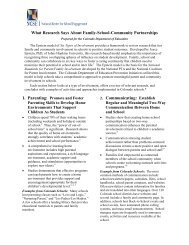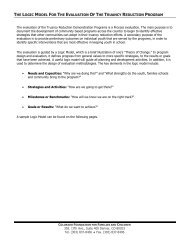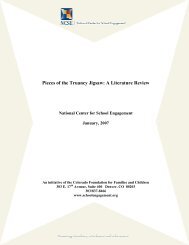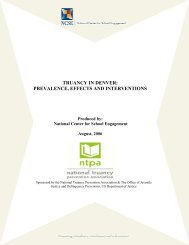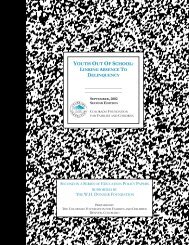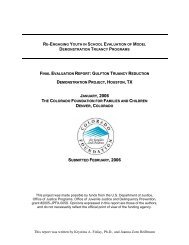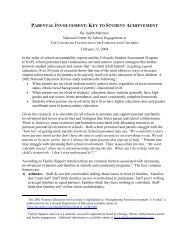Section 1: Academic Achievement - National Center for School ...
Section 1: Academic Achievement - National Center for School ...
Section 1: Academic Achievement - National Center for School ...
Create successful ePaper yourself
Turn your PDF publications into a flip-book with our unique Google optimized e-Paper software.
So, I made three adjustments. First, I added ten minutes between groups to allow myself time<br />
to process the students’ needs and to give myself a chance to reflect on what just took place in<br />
group. Second, I added time at the beginning of the group to allow students to share news<br />
about their day, their life, or anything else. Finally, I took extra time on Monday mornings to<br />
allow students to talk and make connections to each other and me about our weekends. In<br />
addition to this piece, I added an English word wall that served as a place not just to put math<br />
words but also to put words that assisted us in the descriptions we made about what was<br />
meaningful to us in our lives.<br />
In addition to these adjustments, I sought out research around best practices <strong>for</strong> teaching math<br />
and English language learners. I read two articles that had a profound impact on how I<br />
thought about my groups. First, there was an article by Marilyn Burns in the Winter 2005<br />
edition of Leadership Compass entitled “Building a Teaching Bridge from Reading to Math.”<br />
This article particularly piqued my interest because teaching reading is my strength and<br />
teaching math is a competence I am developing. Burns gives ideas about applying what<br />
teachers know and love about teaching reading to teaching math. Second, an article entitled<br />
“Teacher Skills to Support English Language Learners,” in the January 2005 edition of<br />
Educational Leadership, identifies a lack of background knowledge as a contributing factor to<br />
why English Language Learners struggle in the classroom. It made sense to me that this<br />
would also apply to H/HM students. If a student is constantly moving, what sense are they<br />
making of curriculum content as it changes from one school to another and what background<br />
knowledge is missing from their skill set as they attack word problems?<br />
Third Cycle<br />
As I pondered these questions, my thoughts turned to quantitative data. In critically looking<br />
at the assessments we use to anchor the math program and gauge student achievement, I<br />
found a major flaw. The tests, <strong>for</strong>mulated by Kathy Richardson, Mathematical Perspectives<br />
Inc., were offered only in English. A core component of the Richardson assessments is the<br />
scripted questions. I could translate the English script, but the translations wouldn’t be<br />
consistent from student to student unless every one of the nine core assessments was<br />
translated into a script. Furthermore, the district required that translations be done by certified<br />
Action Research to Study Homelessness and High Mobility in <strong>School</strong> Communities 72




